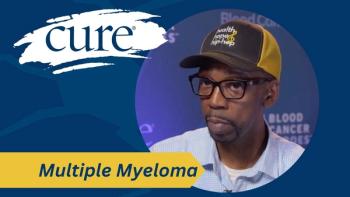
Vyxeos Boosts Survival in Acute Myeloid Leukemia
A phase 3 study showed improved survival rates for patients with high-risk, secondary AML who took Vyxeos.
When compared with cytarabine and daunorubicin (7+3), Vyxeos (CPX-351) reduced risk of death by 31 percent for older patients with high-risk, secondary AML, according to a phase 3 study presented at the 2016 Annual Meeting of the American Society of Clinical Oncology (ASCO).
The study showed a median overall survival (OS) of 9.56 months with Vyxeos versus 5.95 months with cytarabine/daunorubicin. Based on these data, the FDA previously granted Vyxeos a breakthrough therapy designation as a treatment for patients with therapy-related acute myeloid leukemia (t-AML) or AML with myelodysplasia-related changes (AML-MRC).
“Vyxeos should be considered standard first-line treatment for older patients with high-risk AML,” the principal investigator for the study, Jeffrey E. Lancet, senior member and chief of the Leukemia/Myelodysplasia Program at Moffitt Cancer Center, said when presenting the data at ASCO.
Vyxeos is a liposomal formulation containing a fixed combination of cytarabine and daunorubicin in a 5-1 molar ratio that was developed using a system known as “CombiPlex,” which was developed by Celator. This platform is meant to improve upon existing therapies through in vitro studies that illuminate an optimal molar ratio for combinations.
The randomized, controlled phase 3 trial consisted of 309 patients across 39 sites throughout both the United States and Canada who were between the ages of 60 and 75. Patients enrolled in the study were split into either an age group consisting of patients between the ages of 60 to 69 or from 70 to 75.
Those enrolled were further stratified based on AML type. Patients had either therapy-related AML, AML with a history of MDS with and without prior HMA therapy, AML with a history of CMML, or de novo AML with MDS karyotype.
Patient characteristics were well-balanced between the two arms. Approximately 62 percent of patients in each arm were male. In the Vyxeos arm, 90.2 percent of patients had an ECOG PS of 0 or one, with 85.9 percent of patients in the cytarabine/daunorubicin arm having an ECOG PS of 0 or one. The rate of patients with an ECOG PS of two were 9.8 percent and 14.1 percent, respectively.
Patients were randomized in a 1-1 ratio to receive either Vyxeos (153 patients) or cytarabine/daunorubicin (156 patients). Those receiving Vyxeos were given a first induction of 100u/m2 on days one, three and five. Patients in the control arm received daily cytarabine 100 mg/m2 for seven days, followed by daunorubicin 60 mg/m2 on days one, two and three. Second induction for patients enrolled in the Vyxeos arm was 100u/m2 on days one and three, while patients receiving conventional cytarabine and daunorubicin were given cytarabine 100mg/m2 daily for five days with daunorubicin 60 mg/m2 on days one and two.
At 12 months, 41.5 percent of patients enrolled in the Vyxeos arm remained alive versus 27.6 percent in the cytarabine/daunorubicin arm. At 24 months, 31.1 percent of patients enrolled in the Vyxeos arm of the study remained alive compared with 12.3 percent with cytarabine/daunorubicin.
The median event-free survival was 2.53 months with Vyxeos versus 1.31 months (1.08-1.64) with cytarabine/daunorubicin.
Induction response rates (complete remission [CR] plus CR with incomplete hematologic recovery [CRi]) were 47.7 percent for Vyxeos versus 33.3 percent for cytarabine/daunorubicin, yielding a relative benefit of 43.2 percent with the investigational treatment. For CR alone, the rates were 37.3 percent and 25.6 percent, between Vyxeos and cytarabine/daunorubicin, respectively.
Patients who achieved a CR or CRi were eligible to receive consolidation chemotherapy. In the investigation arm, consolidation Vyxeos was administered at 65 u/m2 on days one and three. In the control arm, consolidation therapy consisted of daily cytarabine at 100 mg/m2 for five days and daunorubicin at 60mg/m2 on days one and two (5+2).
“We dose-reduced patients during the consolidation phase due to concerns that were raised during the phase 2 study that delayed count recovery may occur, and we didn’t want to run into problems of harming patients during remission,” said Lancet.
As a primary measurement of toxicity and safety, the researchers analyzed the early mortality rate. “What we determined was that there appeared to be a moderately decreased risk of early mortality at both 30 days and 60 days favoring Vyxeos compared to cytarabine/daunorubicin,” said Lancet.
The rates of grade 3 to 5 nonhematologic adverse events (AEs) were similar between the two arms. Common grade 3 to 5 AEs occurring in the two arms included febrile neutropenia (68 percent with Vyxeos vs 71 percent with cytarabine/daunorubicin), pneumonia (20 percent vs 15 percent), hypoxia (13 percent vs 15 percent), sepsis (9 percent vs 7 percent), hypertension (10 percent vs 5 percent), respiratory failure (7 percent each), fatigue (7 percent vs 6 percent), bacteremia (10 percent vs 2 percent) and ejection fraction decreased (5 percent each).
As a measure of hematologic toxicity, the researchers assessed blood count recovery in patients achieving a CR or CRi. Patients who received either one or two inductions of Vyxeos had an approximately seven-day delay in count recovery of neutrophils and platelets compared with the cytarabine/daunorubicin group. “We did not observe any increased incidence of early death as a function of delayed count recovery,” Lancet noted.
The researchers also assessed outcomes specifically among patients who underwent hematopoietic stem cell transplantation (HSCT). About one-third of patients underwent HSCT during the study and these patients were well-balanced in baseline characteristics between the two arms.
A sensitivity analysis at the time of transplant showed that there was a trend toward improved OS in patients who received Vyxeos compared with cytarabine/daunorubicin. The median OS was 7.75 months versus 5.55 months, respectively.
In January 2015 the FDA granted Fast Track status to Vyxeos for the treatment of elderly patients with secondary AML. The designation was based on the results of two phase 2 studies. In these studies, Vyxeos showed promising results for patients with newly diagnosed and relapsed AML.
Celator, which was recently acquired by Jazz Pharmaceuticals, reported in a press release that it intends to submit a new drug application to the FDA for Vyxeos by the end of the third quarter of 2016.




